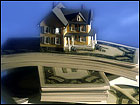
New York (CNN/Money) -
Don't expect relief soon if your home insurance premiums just increased. Multi-billion claims resulting from the terrorist attacks of September 11 have meant more financial pain for insurance companies, pain they can only relieve by raising your rates.
Insurance payouts from September 11 are estimated to run $20 billion to $40 billion. That's prompted reinsurers -- companies like Berkshire Hathaway, Lloyds, Munich Re and Swiss Re -- to raise the rates they charge to insure the insurance companies.
Those higher costs are now getting passed along by insurance companies to homeowners, said Insurance Information Institute spokesperson Carolyn Gorman.
This year, the average annual policy for homeowners insurance will climb to $567 in 2002, a six percent increase, according to a study for the Insurance Information Institute. Independent Insurance Agents and Brokers of America estimates price hikes will climb even higher -- about 10 percent -- when homeowners renew their policies this year.
Of course, rates vary greatly depending on such factors as a homeowner's proximity to the nearest fire department and the age, size and location of their dwelling. In North Dakota, the cheapest state, the average policy runs $403. In Texas, premiums generally run $861 annually.
Insurance claims piling up
For homeowners, coping with rate increases should be familiar terrain. Premiums have climbed 38 percent since 1995. Massive natural disasters drove much of the rate hikes throughout the 1990s, which saw events like Hurricane Andrew in 1992 and the Northridge earthquake in 1994. Andrew cost insurers $19.6 billion. The Northridge quake cost $16.2 billion.
Now, in addition to fire, tornadoes, and terrorists, there's mold. Recently, expensive, high-profile lawsuits stemming from mold damage have pushed premiums higher and have alarmed both insurance companies and homeowners.
A growing problem
In one of the most notable cases, a Texas family began coughing blood while black mold destroyed their 11,000 square-foot mansion. They were awarded $32 million in damages. That high-profile cases seems to have encouraged similar suits. In the first quarter of 2001, mold claims in Texas increased by 581 percent.
| |
 Related Stories
Related Stories
| |
| | |
| | |
|
But the Lone Star state isn't the only one affected. In April, television celebrity Ed McMahon sued his insurance company for $20 million after alleging that mold destroyed his California house and killed his family dog. And mold has been a major problem for about 30 percent of new homes, said Madelyn Flannagan, spokesman for Independent Insurance Agents and Brokers of America.
"It's a new phenomenon based on airtight construction, which allows the mold to grow," Flannagan added. "If you've got this kind of construction you can expect to pay substantially higher premiums, or have mold excluded from their policy or you may not be able to get insurance with the company you want."
She recommends that consumers building new homes be sure to tell their architects and builders that they don't want airtight construction.
The aging of America's homes
Rising home repair costs have added more pressure to insurance rates. The cost of repairs has increased about 5 percent a year, according to the National Association of Homebuilders.
The biggest reason for those increases is simply that homes are getting older. "The median age of housing stock is now 30 years old," said Gopal Ahluwalia, director of research at NAH. "Everything in the home has a certain life. Nothing lasts forever except for the foundation, which can last 100 years."
In the face of all this, there are still myriad ways consumers can lower their premiums. These include improving their home security systems or by "bundling" costs -- that is, buying homeowners and auto insurance from the same company. Raising a deductible by $500 to $1,000 can shave as much as 15 percent off premium costs. For other tips on lowering insurance premiums see our story.

|

